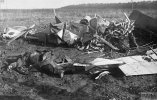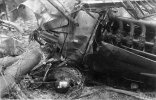dinomartino1
Well-Known Member
A flight of De Havilland long distance day-bombing machines. Serny aerodrome, 17 February 1918.
Close-up of cockpit of Bristol Fighter
The armoury of the 149th Nlight Bombing Squadron at their aerodrome near St. Omer, 19 July 1918.
Pilots studying maps spread out on the elevator of a De Havilland day bomber. Serny aerodrome, 17 February 1918.


